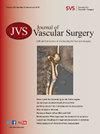Practice patterns in utilization of atherectomy and embolic protection devices in inpatient and outpatient treatment settings
IF 3.9
2区 医学
Q1 PERIPHERAL VASCULAR DISEASE
引用次数: 0
Abstract
Objective
The frequency of atherectomy in lower extremity arterial disease has increased substantially over the past several years, specifically in the office-based laboratory (OBL) setting, yet the efficacy compared with other interventions and the consequences of distal embolization remain unknown. Embolic protection devices (EPDs) have been used at varying rates depending on physician and practice setting. Previous studies have described lesion characteristics to consider when weighing the benefits and drawbacks associated with device use. Our study focuses on the use of atherectomy and EPDs in femoropopliteal arterial disease to better characterize resource use trends and postoperative outcomes in the inpatient and OBL interventional settings.
Methods
We conducted a retrospective analysis on endovascular interventions performed for femoral-popliteal occlusive disease that were entered into the Vascular Quality Initiative data registry between 2017 and 2021. A one:one greedy match, adjusted analysis based on inpatient or OBL location of procedure was used to compare the groups. Hierarchical logistical regression with selective use of principal component analysis was used to further explore the differences in EPD use and immediate postoperative outcomes. A proportional hazard model was used to demonstrate differences in reintervention rates up to 2 years postoperatively between patients who underwent atherectomy in the inpatient vs OBL treatment setting.
Results
2849 matched pairs were inlcuded in the final analysis. In our cohort, there was 22% EPD use overall, 40% in the hospital setting and 4.4% in the OBL setting (P < .001). Among the patients with available follow-up information, OBL intervention setting increased probability of reintervention by 18% at 2 years postoperatively compared with the inpatient setting; however, there was no difference associated with EPD placement and rate of reintervention.
Conclusions
Use of EPDs in the OBL setting compared with the hospital setting is dramatically decreased; however, no increased incidence of postoperative complications was seen compared to procedures performed in the hospital setting when controlling for patient and lesion characteristics. Patients with available follow-up data were more likely to undergo ipsilateral reintervention between 6 months and 2 years postoperatively if atherectomy was done in the OBL setting. Dedicated studies are encouraged to ensure patient safety, effective resource allocation, and long-term efficacy of OBL atherectomy as an ever-growing number of peripheral arterial procedures are transitioned to the OBL setting.
在住院和门诊治疗环境中使用动脉粥样硬化切除术和栓塞保护装置的实践模式。
目的:在过去几年中,下肢动脉疾病的动脉粥样硬化切除术频率大幅增加,特别是在诊室实验室(OBL)环境中,但与其他干预措施相比,其疗效以及远端栓塞的后果仍不清楚。栓塞保护装置(EPD)的使用率因医生和诊疗环境而异。之前的研究描述了在权衡与设备使用相关的利弊时需要考虑的病变特征。我们的研究重点是股骨头动脉疾病中动脉粥样硬化切除术和EPD的使用情况,以更好地描述住院患者和OBL介入治疗环境中的资源使用趋势和术后结果:我们对2017-2021年间输入血管质量倡议(VQI)数据注册表的股动脉-腘动脉闭塞性疾病的血管内介入治疗进行了回顾性分析。采用1:1贪婪匹配、基于住院或OBL手术地点的调整分析来比较各组。有选择性地使用主成分分析的分层逻辑回归进一步探讨了EPD使用和术后即刻结果的差异。使用比例危险模型显示了在住院与OBL治疗环境下接受动脉粥样硬化切除术的患者术后两年内再介入率的差异。在我们的队列中,EPD的总体使用率为22%,在医院环境中为40%,在OBL环境中为4.4%(p结论:在OBL环境中,EPD的使用率为22%,在医院环境中为40%,在OBL环境中为4.4%):然而,在控制了患者和病变特征后,术后并发症的发生率与在医院进行的手术相比并没有增加。有随访数据的患者在术后6个月至2年期间,如果在OBL环境下进行动脉粥样硬化切除术,则更有可能接受同侧再介入治疗。随着越来越多的外周动脉手术过渡到OBL环境,我们鼓励开展专门研究,以确保患者安全、有效的资源分配以及OBL动脉粥样硬化切除术的长期疗效。
本文章由计算机程序翻译,如有差异,请以英文原文为准。
求助全文
约1分钟内获得全文
求助全文
来源期刊
CiteScore
7.70
自引率
18.60%
发文量
1469
审稿时长
54 days
期刊介绍:
Journal of Vascular Surgery ® aims to be the premier international journal of medical, endovascular and surgical care of vascular diseases. It is dedicated to the science and art of vascular surgery and aims to improve the management of patients with vascular diseases by publishing relevant papers that report important medical advances, test new hypotheses, and address current controversies. To acheive this goal, the Journal will publish original clinical and laboratory studies, and reports and papers that comment on the social, economic, ethical, legal, and political factors, which relate to these aims. As the official publication of The Society for Vascular Surgery, the Journal will publish, after peer review, selected papers presented at the annual meeting of this organization and affiliated vascular societies, as well as original articles from members and non-members.

 求助内容:
求助内容: 应助结果提醒方式:
应助结果提醒方式:


